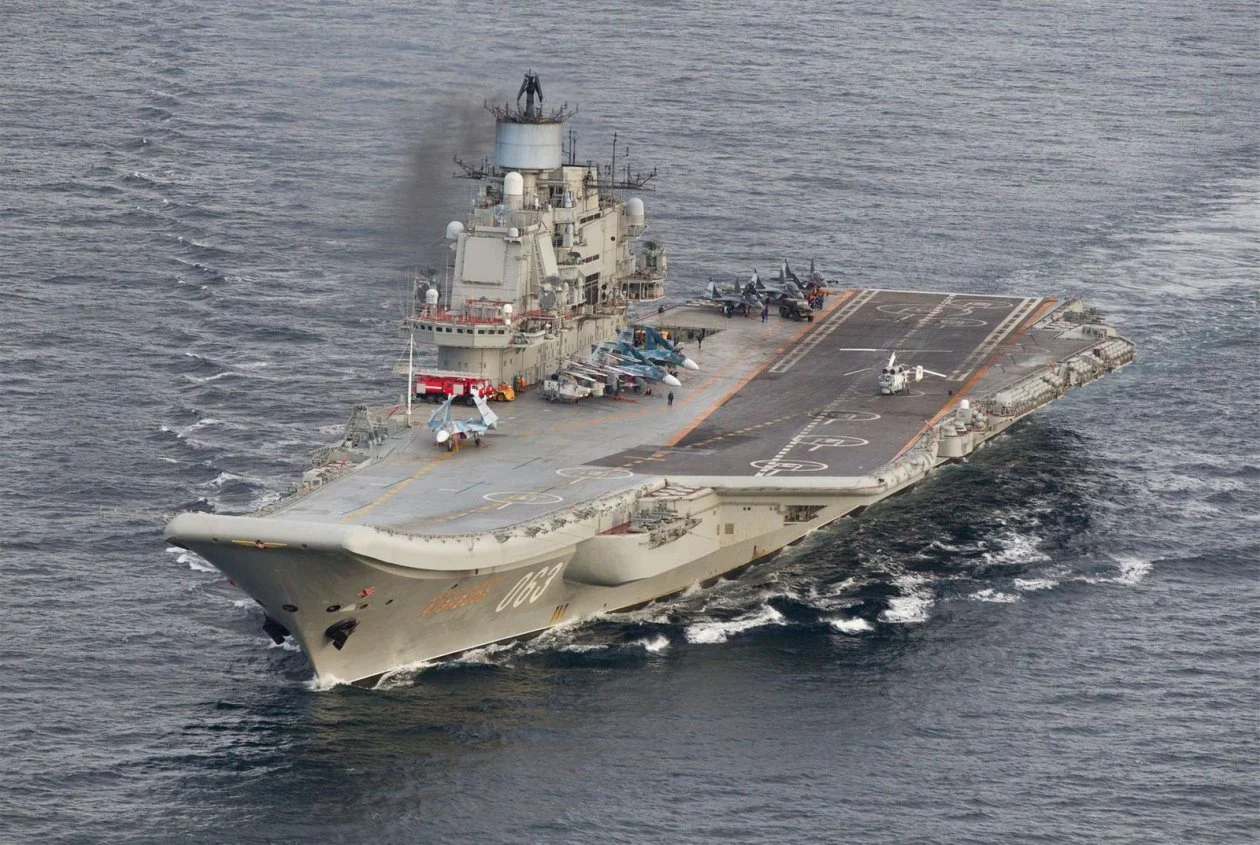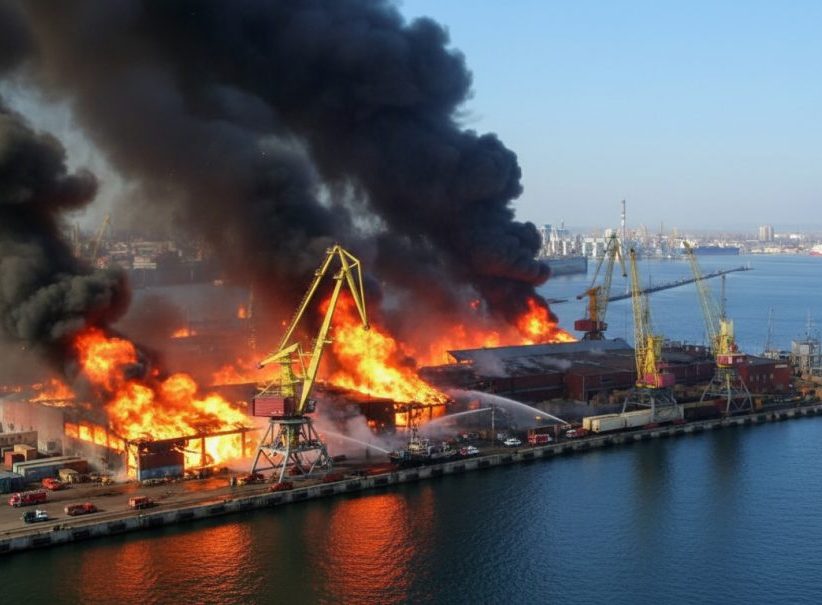Why Does Russia Not Have Its Own Fleet of Aircraft Carriers?
26.02.2021 14:23
16 553
0

Photo: Reuters
Key point: The Soviet navy just could not compete and modern-day Russia remains largely a landpower. Indeed, even now Moscow does not have the capacity to build many more carriers even if it wanted to.
Historically a land power, the Soviet Union grappled with the idea of a large naval aviation arm for most of its history, eventually settling on a series of hybrid aircraft carriers. Big plans for additional ships died with the Soviet collapse, but Russia inherited one large aircraft carrier at the end of the Cold War—that remains in service today.
This first appeared earlier and is being republished due to reader interest.
Although many of the problems that wracked the naval aviation projects of the Soviet Union remain today, the Russian navy nevertheless sports one of the more active aircraft carriers in the world.
History of Russian Naval Aviation
The Soviet Union made several efforts at developing aircraft carriers early in its history, but a lack of resources, combined with a geography that emphasized the importance of land power, made serious investment impossible. During the Cold War, the first naval aviation success were Moskva and Leningrad, a pair of helicopter carriers designed primarily for antisubmarine warfare. These ships, ungainly in appearance, displaced 17,000 tons, could make about thirty knots, and each carried eighteen helicopters. Moskva entered service in 1967, Leningrad in 1969. The Moskvas were succeeded by the Kiev class, much closer to true aircraft carriers. Displacing 45,000 tons, the four Kievs (each built to a slightly different design) could make thirty-two knots and carry a combination of about thirty helicopters and Yak-38 VSTOL fighters.
All of these ships left service at the end of the Cold War; the Moskvas and one of the Kievs were scrapped, two Kievs ended up as museums in China, and one was eventually reconstructed and sold to India as INS Vikramaditya. In the 1980s, the Soviet Union laid down its first two true carriers, although only one was completed before the collapse of the country.
Current State of Russia’s Carrier Force
At the moment, Russia’s only aircraft carrier is the troubled Admiral Kuznetsov. A ski jump carrier, the Kuznetsov displaces some 60,000 tons, can theoretically make thirty knots, and carry a combination of forty-or-so helicopters and jet fighters. Kuzentsov was commissioned in 1990; a sister remained an incomplete hulk for many years until it was purchased by China and eventually finished as Liaoning. In addition to helicopters, Kuznetsov operates MiG-29K and Su-33 fighter bombers. Like previous Russian carriers, Kuznetsov sports a heavier missile armament than most Western ships.
Unfortunately, hiccups with Kuznetsov have also made it difficult for Russia’s naval aviators to remain practiced and effective. The ship has suffered multiple breakdowns over its career, including significant issues with its engines and recovering aircraft. Many of these difficulties came as consequence of the dramatic decline of maintenance funding at the end of the Cold War, but some was the inevitable result of inexperience with the platform type. Admiral Kuznetsov has engaged in several prestige cruises, but its most notable service came in 2016 off of Syria. After a much publicized journey to the Mediterranean, Kuznetsov conducted combat operations for two months. The operations had more of a publicity impact than a real military effect, and Kuznetsov lost two aircraft (one MiG-29K and one Su-33) to accidents. The carrier is currently in refit.
To support Kuznetsov, Russia attempted to purchase a pair of French assault carriers, but the conquest and annexation of Crimea forced France to cancel the sale. These ships would have served as amphibious platforms with antisubmarine (ASW) capabilities, but also would have given the Russian navy experience with relatively large, technologically advanced vessels. Indeed, part of the deal would have allowed Russia to construct two Mistrals to French specifications in its own yards, which would have provided a major boon to Russian shipbuilding.
Strategic Rationale
Russia has a unique maritime geography, with four fleets operating from four coasts practically incapable of offering mutual support. During the Soviet period, carriers supported the fleet of nuclear ballistic missile submarines, offering air and ASW protection for the bastions in which these subs patrolled. This mission allowed the carriers to de-emphasize strike capabilities in favor of more defensive weaponry. More recently, the Russian navy has used Admiral Kuznetsov primarily as a vehicle for influence and prestige. Along with the nuclear battlecruiser Pyotr Velikiy and a few other ships, Kuznetsov is a visible manifestation of Russian naval power, forcing other nations to take note of Russian interests. As the Syria mission suggests, in the future Russia may focus more on developing strike capabilities in order to project power further.
The Future
Russia has cancelled more carriers than most countries have contemplated. In the 1970s the Soviet Union considered the 72,000-ton Orel-class nuclear aircraft carrier, but opted instead for the Kievs and the ships that would eventually become Kuznetsov and Liaoning. The Soviets laid down an 80,000-ton carrier named Ulyanovsk in 1988, but scrapped the incomplete ship when the Cold War ended.
Russian defense planners often announce projects as a means of gaining resources and prestige, rather than as part of a plan to build anything in particular. At one point, President Dmitri Medvedev suggested that Russia would build and operate six aircraft carriers by 2025; obviously, that’s not going to happen. But there is an existing plan for the Project 23000E Shtorm carrier, a 100,000-ton nuclear-powered supercarrier employing EMALS catapults and a variety of other modern technologies. The carrier would presumably fly MiG-29K fighters, although the age of that aircraft would suggest the need for a replacement. The ability of Russia to build this ship under current circumstances is in deep question, however.
Conclusion
The aviation capability of the Russian navy is dangling by a thread. Kuznetsov is old and in poor condition, and no carrier is even close to be laid down. The Russian surface fleet has not received a great deal of attention in the latest military modernization plans, and the Russian shipbuilding industry has not constructed a warship the size and sophistication of Kuzentsov since… well, Kuznetsov.
That said, the Kremlin seems to view aircraft carriers as an important contributor to national prestige. The Russian navy took great pains to get Kuznetsov into position to support operations in Syria, and despite the embarrassment associated with that, has now pushed the carrier into a major refit. If the Kremlin determines that it needs a carrier to keep pace with France, Britain, China and India, it will need to begin seriously considering how to build or acquire such a ship. It is not inconceivable that Moscow may consider ordering a carrier from Chinese yards in the future, however profound a reversal that might seem. Otherwise, Russia needs to start solidifying its construction timelines soon.
The National Interest
Historically a land power, the Soviet Union grappled with the idea of a large naval aviation arm for most of its history, eventually settling on a series of hybrid aircraft carriers. Big plans for additional ships died with the Soviet collapse, but Russia inherited one large aircraft carrier at the end of the Cold War—that remains in service today.
This first appeared earlier and is being republished due to reader interest.
Although many of the problems that wracked the naval aviation projects of the Soviet Union remain today, the Russian navy nevertheless sports one of the more active aircraft carriers in the world.
History of Russian Naval Aviation
The Soviet Union made several efforts at developing aircraft carriers early in its history, but a lack of resources, combined with a geography that emphasized the importance of land power, made serious investment impossible. During the Cold War, the first naval aviation success were Moskva and Leningrad, a pair of helicopter carriers designed primarily for antisubmarine warfare. These ships, ungainly in appearance, displaced 17,000 tons, could make about thirty knots, and each carried eighteen helicopters. Moskva entered service in 1967, Leningrad in 1969. The Moskvas were succeeded by the Kiev class, much closer to true aircraft carriers. Displacing 45,000 tons, the four Kievs (each built to a slightly different design) could make thirty-two knots and carry a combination of about thirty helicopters and Yak-38 VSTOL fighters.
All of these ships left service at the end of the Cold War; the Moskvas and one of the Kievs were scrapped, two Kievs ended up as museums in China, and one was eventually reconstructed and sold to India as INS Vikramaditya. In the 1980s, the Soviet Union laid down its first two true carriers, although only one was completed before the collapse of the country.
Current State of Russia’s Carrier Force
At the moment, Russia’s only aircraft carrier is the troubled Admiral Kuznetsov. A ski jump carrier, the Kuznetsov displaces some 60,000 tons, can theoretically make thirty knots, and carry a combination of forty-or-so helicopters and jet fighters. Kuzentsov was commissioned in 1990; a sister remained an incomplete hulk for many years until it was purchased by China and eventually finished as Liaoning. In addition to helicopters, Kuznetsov operates MiG-29K and Su-33 fighter bombers. Like previous Russian carriers, Kuznetsov sports a heavier missile armament than most Western ships.
Unfortunately, hiccups with Kuznetsov have also made it difficult for Russia’s naval aviators to remain practiced and effective. The ship has suffered multiple breakdowns over its career, including significant issues with its engines and recovering aircraft. Many of these difficulties came as consequence of the dramatic decline of maintenance funding at the end of the Cold War, but some was the inevitable result of inexperience with the platform type. Admiral Kuznetsov has engaged in several prestige cruises, but its most notable service came in 2016 off of Syria. After a much publicized journey to the Mediterranean, Kuznetsov conducted combat operations for two months. The operations had more of a publicity impact than a real military effect, and Kuznetsov lost two aircraft (one MiG-29K and one Su-33) to accidents. The carrier is currently in refit.
To support Kuznetsov, Russia attempted to purchase a pair of French assault carriers, but the conquest and annexation of Crimea forced France to cancel the sale. These ships would have served as amphibious platforms with antisubmarine (ASW) capabilities, but also would have given the Russian navy experience with relatively large, technologically advanced vessels. Indeed, part of the deal would have allowed Russia to construct two Mistrals to French specifications in its own yards, which would have provided a major boon to Russian shipbuilding.
Strategic Rationale
Russia has a unique maritime geography, with four fleets operating from four coasts practically incapable of offering mutual support. During the Soviet period, carriers supported the fleet of nuclear ballistic missile submarines, offering air and ASW protection for the bastions in which these subs patrolled. This mission allowed the carriers to de-emphasize strike capabilities in favor of more defensive weaponry. More recently, the Russian navy has used Admiral Kuznetsov primarily as a vehicle for influence and prestige. Along with the nuclear battlecruiser Pyotr Velikiy and a few other ships, Kuznetsov is a visible manifestation of Russian naval power, forcing other nations to take note of Russian interests. As the Syria mission suggests, in the future Russia may focus more on developing strike capabilities in order to project power further.
The Future
Russia has cancelled more carriers than most countries have contemplated. In the 1970s the Soviet Union considered the 72,000-ton Orel-class nuclear aircraft carrier, but opted instead for the Kievs and the ships that would eventually become Kuznetsov and Liaoning. The Soviets laid down an 80,000-ton carrier named Ulyanovsk in 1988, but scrapped the incomplete ship when the Cold War ended.
Russian defense planners often announce projects as a means of gaining resources and prestige, rather than as part of a plan to build anything in particular. At one point, President Dmitri Medvedev suggested that Russia would build and operate six aircraft carriers by 2025; obviously, that’s not going to happen. But there is an existing plan for the Project 23000E Shtorm carrier, a 100,000-ton nuclear-powered supercarrier employing EMALS catapults and a variety of other modern technologies. The carrier would presumably fly MiG-29K fighters, although the age of that aircraft would suggest the need for a replacement. The ability of Russia to build this ship under current circumstances is in deep question, however.
Conclusion
The aviation capability of the Russian navy is dangling by a thread. Kuznetsov is old and in poor condition, and no carrier is even close to be laid down. The Russian surface fleet has not received a great deal of attention in the latest military modernization plans, and the Russian shipbuilding industry has not constructed a warship the size and sophistication of Kuzentsov since… well, Kuznetsov.
That said, the Kremlin seems to view aircraft carriers as an important contributor to national prestige. The Russian navy took great pains to get Kuznetsov into position to support operations in Syria, and despite the embarrassment associated with that, has now pushed the carrier into a major refit. If the Kremlin determines that it needs a carrier to keep pace with France, Britain, China and India, it will need to begin seriously considering how to build or acquire such a ship. It is not inconceivable that Moscow may consider ordering a carrier from Chinese yards in the future, however profound a reversal that might seem. Otherwise, Russia needs to start solidifying its construction timelines soon.
The National Interest
Comments
Комментарии для сайта Cackle
Читайте также:
От слов к делу: Россия сжигает одесские мосты и суда, ломая хребет украинской экономике
Одесса во тьме: Россия нанесла мощный комбинированный удар по порту, энергетике и логистике Украины! Горящее турецкое судно с маслом, разрушенный мост из Румынии, отключения света и воды до 16 декабря. Это ответ на атаки СБУ по российским танкерам. Путин держит слово — номенклатура ударов расширяется. Черное море кипит: блокада портов грозит экономическим крахом Киеву и новым витком эскалации.
Война приблизилась. Британия помогает наносить удары по России
15.12.2025 10:34
Британия, помогая ВСУ наносить удары по России, приближает войну с ней.
Путин переиграл всех: Запад самоуничтожается, Россия пожинает плоды
Путин уже выиграл: Запад в руинах, а Россия празднует триумф! Foreign Policy: конфликт на Украине расколол НАТО. Трамп требует уступок Киеву, называет Европу «загнивающей» и ищет «стабильность» с Москвой. В России — 70-80% поддержки СВО, единство и крепкая экономика. Европа в шоке ищет автономию. Главный трофей Путина — развал трансатлантического альянса.
Всё, доигрались: Россия забирает западные активы. Сумма фантастическая. И это только начало
15.12.2025 13:21
Евросоюз окончательно отказался от временного характера заморозки русских резервов, превратив их в инструмент долгосрочного политического давления.
«Орешник» у границ НАТО: Россия готовит ядерный сюрприз Европе, всего 8 минут до Лондона
Россия готовится завершить развертывание ракетного комплекса «Орешник» в Белоруссии к концу декабря 2025 года. По данным разведки Украины, это инструмент давления на НАТО и ЕС: ракета сократит время подлёта до европейских столиц (до Лондона — всего 8 минут) и защитит систему от ударов ВСУ. Комплекс способен нести ядерные боеголовки, развивает гиперзвуковую скорость. Строительство базы под Минском
Comments




